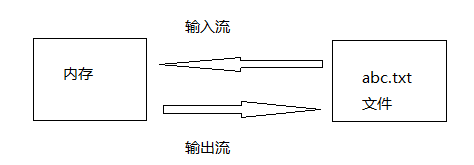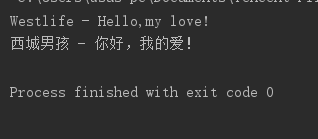一、流的概念
流:数据在数据源(文件)和程序(内存)之间经历的路径。
输入流:数据从数据源(文件)到程序(内存)的路径。
输出流:数据从程序(内存)到数据源(文件)的路径。
以内存为参照,如果数据向内存流动,则是输入流,反之则是输出流

字节流:FileInputStream用来读取文件
FileOutputStream用来写入到文件
字符流:FileReaderBufferedReader用来读取文件
FileWriteBufferedWrite用来写入到文件
二、操作用法
1.获取文件对象,针对该对象进行一些基本操作

1 //创建一个文件对象 2 File f = new File("F:\test\sheet.xls"); 3 //得到文件的路径 4 System.out.println("文件路径"+f.getAbsolutePath()); 5 //得到文件的大小,字节数 6 System.out.println("文件大小"+f.length()); 7 //可读属性 8 System.out.println("可读"+f.canRead());
2.创建文件(判断该文件是否存在,若存在则弹出提示,若不存在则进行创建)

1 //创建文件 2 File f = new File("F:\test\test.txt"); 3 //判断该文件是否存在 4 if(!f.exists()) 5 { 6 //可以创建 7 try { 8 f.createNewFile(); 9 } catch (IOException e) { 10 e.printStackTrace(); 11 } 12 } 13 else 14 { 15 System.out.println("改文件已存在,创建失败!"); 16 }
3.创建文件夹(条件同上)

1 //创建文件夹 2 File f = new File("F:\test"); 3 if (f.isDirectory())//判断是不是一个文件夹 4 { 5 System.out.println("创建失败"); 6 } else { 7 f.mkdir(); 8 }
Tips:这里写明一下isFile()、exists()和isDirectory()的区别
isFile():判断是否文件,也许可能是文件或者目录。
exists():判断是否存在,可能不存在。
isDirectory(): 判断该对象是否是一个文件夹。
4.列出某文件夹下面的所有文件(此时对象还是File,File没有文件和文件夹之分,对电脑来讲,文件夹只是一种特殊的文件)

1 File f = new File("F:\testt"); 2 if (f.isDirectory()) { 3 File filelists[] = f.listFiles(); 4 for (int i = 0; i < filelists.length; i++) 5 { 6 System.out.println("文件名是:"+filelists[i].getName()); 7 } 8 }
5.FileInputStream的使用

1 /** 2 * 演示FileInputStream类的使用 3 */ 4 package com.test2; 5 6 import java.io.*; 7 8 public class Demo11_2 { 9 public static void main(String[] args) { 10 11 //得到一个文件对象 12 File f = new File("F:\tt\test.txt"); 13 FileInputStream fis = null; 14 //因为file没用读写的能力,所以需要使用FileInputStream 15 try { 16 fis = new FileInputStream(f); 17 18 //定义一个字节数组(相当于一个缓存,如果你的对象"f"是一个很大的文件,内存不够用,所以只能一点一点地读取) 19 byte[] bytes = new byte[1024]; 20 //实际读取到的字节数 21 int n = 0; 22 //循环读取 23 //如果read()返回-1,则说明读取完毕 24 while ((n = fis.read(bytes)) != -1) { 25 //将字节转换成string 26 //此时实例化s时,要注意指定编码格式,电脑上文档默认的是GBK,而我这边默认的是utf-8, 27 //所以如果不指定格式的话,最后输出的中文会出现乱码 28 String s = new String(bytes, 0, n,"GBK"); 29 System.out.println(s); 30 } 31 } catch (Exception e) { 32 e.printStackTrace(); 33 } finally { 34 //关闭文件流(关键) 35 try { 36 if (fis != null) { 37 fis.close(); 38 } 39 } catch (IOException e) { 40 e.printStackTrace(); 41 } 42 } 43 } 44 }
读取成功..
6.FileOutputStream的使用

1 /** 2 * 演示FileOutputStream的使用 3 */ 4 package com.test2; 5 6 import java.io.*; 7 8 public class Demo11_3 { 9 public static void main(String[] args) { 10 File f = new File("F:\tt\test.txt"); 11 //字节输出流 12 FileOutputStream fos = null; 13 14 try { 15 fos = new FileOutputStream(f); 16 17 String s = "Westlife - Better manrn西城男孩 - 更完美的人"; 18 19 fos.write(s.getBytes()); 20 } catch (Exception e) { 21 e.printStackTrace(); 22 } finally { 23 try { 24 if (fos != null) { 25 fos.close(); 26 } 27 } catch (IOException e) { 28 e.printStackTrace(); 29 } 30 } 31 32 } 33 }

写入成功..
7.字节流的操作(通过写入写出来实现图片的拷贝,操作byte)

1 /** 2 * 图片拷贝 3 */ 4 package com.test2; 5 6 import java.io.*; 7 8 public class Demo11_4 { 9 public static void main(String[] args) { 10 //先把图片读入到内存,再写到某个文件 11 //因为是二进制文件,因此只能用字节流完成 12 File f = new File("F:\tt\Westlife.jpg"); 13 //输入流 14 FileInputStream fis = null; 15 //输出流 16 FileOutputStream fos = null; 17 18 try { 19 fis = new FileInputStream(f); 20 //或者省略上面实例化File,直接在这里fis = new FileInputStream("F:ttWestlife.jpg");也可以 21 22 fos = new FileOutputStream("D:\练习\Westlife.jpg"); 23 byte[] bytes = new byte[1024]; 24 int n = 0;//记录实际读取到的字节数 25 //循环读取 26 while ((n = fis.read(bytes)) != -1) { 27 //输出到指定文件 28 fos.write(bytes); 29 } 30 } catch (Exception e) { 31 e.printStackTrace(); 32 } finally { 33 //关闭打开的文件流 34 if (fos != null) { 35 try { 36 fos.close(); 37 } catch (IOException e) { 38 e.printStackTrace(); 39 } 40 } 41 42 if (fis != null) { 43 try { 44 fis.close(); 45 } catch (IOException e) { 46 e.printStackTrace(); 47 } 48 } 49 } 50 } 51 }
8.字符流的操作(操作char)

1 /** 2 * 字符流操作 3 */ 4 package com.test2; 5 6 import java.io.*; 7 8 public class Demo11_5 { 9 public static void main(String[] args) { 10 //文件取出字符流对象(输入流) 11 FileReader fr = null; 12 //写入到文件(输出流) 13 FileWriter fw = null; 14 15 //创建一个fr对象 16 try { 17 //创建输入对象 18 fr = new FileReader("F:\tt\test.txt"); 19 //创建输出对象 20 fw = new FileWriter("D:\练习\test2.txt"); 21 22 23 //读入到内存 24 int n = 0;//记录实际读取到的字符数 25 char c[] = new char[1024]; 26 while ((n = fr.read(c)) != -1) { 27 //输入 28 // String s = new String(c,0,n); 29 // System.out.println(s); 30 //输出 31 //方法一:fw.write(c); 32 方法二://指定输出的起始位置 33 fw.write(c, 0, n); 34 } 35 } catch (Exception e) { 36 e.printStackTrace(); 37 } finally { 38 //关闭文件流 39 if (fr != null) { 40 try { 41 fr.close(); 42 } catch (IOException e) { 43 e.printStackTrace(); 44 } 45 } 46 47 if (fw != null) { 48 try { 49 fw.close(); 50 } catch (IOException e) { 51 e.printStackTrace(); 52 } 53 } 54 } 55 56 } 57 }
9.缓冲字符流(提高了效率,直接操作String)

1 /** 2 * 缓冲字符流操作 3 */ 4 package com.test2; 5 6 import java.io.*; 7 8 public class Demo11_6 { 9 public static void main(String[] args) { 10 BufferedReader br = null; 11 BufferedWriter bw = null; 12 13 //先创建FileReader对象 14 FileReader fr = null; 15 16 //创建FileWriter对象 17 FileWriter fw = null; 18 try { 19 fr = new FileReader("F:\tt\test.txt"); 20 br = new BufferedReader(fr); 21 22 23 fw = new FileWriter("D:\练习\test3.txt"); 24 bw = new BufferedWriter(fw); 25 26 //循环读取文件 27 String s = ""; 28 while ((s = br.readLine()) != null) { 29 //读取到内存 30 //System.out.println(s); 31 32 //输出到磁盘 33 bw.write(s+"rn"); 34 } 35 } catch (Exception e) { 36 e.printStackTrace(); 37 } finally { 38 //注:如果文件流不关闭的话会影响后续对该文件的操作,比如可能读不到该文件的数据 39 if (br != null) { 40 try { 41 { 42 br.close(); 43 } 44 } catch (IOException e) { 45 e.printStackTrace(); 46 } 47 } 48 49 if (bw != null) { 50 try { 51 { 52 bw.close(); 53 } 54 } catch (IOException e) { 55 e.printStackTrace(); 56 } 57 } 58 } 59 } 60 }
内容来源于网络如有侵权请私信删除
- 还没有人评论,欢迎说说您的想法!







 客服
客服


